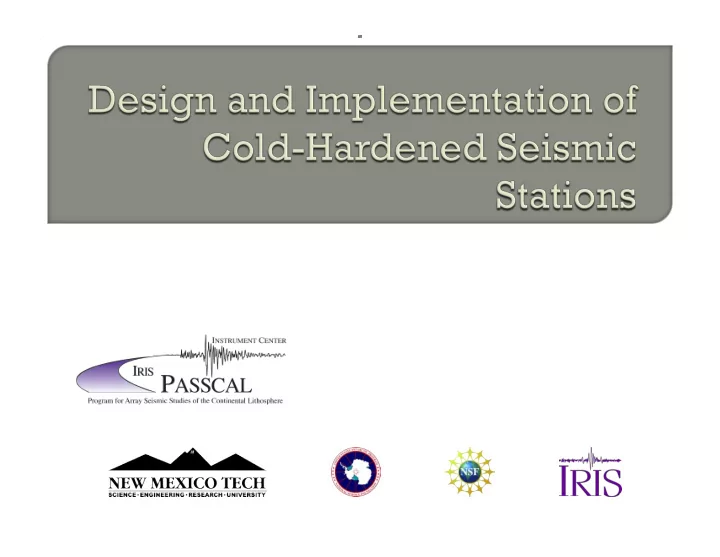

T. Parker, B. Beaudoin, B. Bonnett, J. Fowler, and K. Anderson
MRI – Development of a Power and Communications System for Remote Autonomous Polar Observations Second year development deployed this winter Leveraged development to support IPY science MRI – Acquisition of Broadband Seismic Stations for Polar Regions Acquisition of 37 cold-hardened stations 20 currently deployed at AGAP & POLENET EGU 2008 2
Motivation Demand for year-round recording Unify equipment pool Simplify field logistics & support NSF EGU 2008 3
Reduce Power Work with manufacturers Low bandwidth SOH Harness DAS heat Increase battery potential Operate within specification Simplify deployment Minimize ground time & payload Utilize Primary batteries Simple Dependable at extreme cold Highest energy density EGU 2008 4
Proven year round operation Low power (<1.5W) Leverage DAS heat to maintain station temperature ~20-25°C above ambient 275 kg total station weight (with Lithium) Easily deployed AGAP stations installed on average 2 hours 2-way station communications SOH Command & control Power management EGU 2008 5
Rated to -45°C, was -40°C 32MB of buffering allows longer time between baler cycles saving 2/3 of the baler power budget from last year 16GB of -45°C rated station storage device (media rated to -55°C) Power budget for Q330, 3 channels @ 40sps and continuous GPS is ~0.8 watts EGU 2008 6
Leveraged GSN development of cold rated borehole seismometer Coldest rated and lowest powered broadband sensor 0.3 watts, -55°C rated, tested to -60°C EGU 2008 7
Successfully used for one season at South Pole 20 currently deployed for POLENET and AGAP 0.65 watts, -20°C rated EGU 2008 8
Deployed but still in alpha testing of phase 1 of a two phase development Yearly power budget for once-a- day SOH, 5AH Data rate ~2Kb/s Status and data snippets Command and control of a subset of important station commands and reporting schedules Developed in collaboration with XEOS Technologies Integration of Vaisala weather station - data averaging, reporting and power control 10s data snippet from Antarctica EGU 2008 9
Design Hardigg Case 94cm x 94cm x 94cm 7.6 cm Thick Foam Insulation 2.5 cm Thick Vacuum Panel 2.5 cm Thick Foam Insulation 1.9 cm Wall Cable Insulation EGU 2008 10
Internal DAS Temperature 0.0 03/06/2011 04/06/2011 05/06/2011 06/06/2011 07/06/2011 08/06/2011 09/06/2011 10/06/2011 11/06/2011 12/06/2011 -10.0 -20.0 Temperature (°C) -30.0 -40.0 -50.0 -60.0 Ambient -70.0 Large Box Surface -80.0 Small Box Buried Date (mm/dd/yyyy) EGU 2008 11
Offield Mini-Vault Phenolic Sensor Base Double-Wall Insulated Dome Stretched Steel Dome-Retainer EGU 2008 12
Phenolic Sensor Base Foam Base Sensor Insulation Double Wall Insulated Dome EGU 2008 13
Folded size: 203cm x 122cm x 15cm Weight: 57 kg Quickly Deployable Use on Rock or Snow 2x 80 Watt Sharp Solar Panels Integrated Enclosure Cradle Aluminum panel backing EGU 2008 14
Folded Size: 213cm x 122cm x 15cm Weight: 68 kg Quickly Deployable 3x 80 Watt Sharp Solar Panels EGU 2008 15
New power switching board, lower parasitic power Switches between chargeable and primary batteries Charge controller, can use one charging source for two battery banks e.g. preferential charging LVD and HVR settable Cold culled to -50°C, 5 out of 30 fail because of charge controllers EGU 2008 16
Lithium Thionyl Chloride primary battery pack for winter operations 190 A-h/unit between 18.5-15.5V 10 unit pack 30,000 W-h at room temperature 23,000 W-h at -30°C 16,500 W-h at -55°C AGM secondary, solar charged 2x100 A-h 190 A-h unit prior to shrink wrap
DAS Temperature System Voltage EGU 2008 18
New station box design New solar mount Better insulated Low wind, high-latitude Double vacuum panel environment Insulated cable harness Single pole More durable Hard liner 32kg More easily fabricated 3x30W panels Smaller and lighter 76cm x 76cm x 84cm EGU 2008 19
New cold-rated solar charge controller development Iridium phase two Request event data Realtime low sample rate data (<10Hz) Parallel iridium development with Quanterra Alternate battery technologies Lithium Ion EGU 2008 20
http://www.passcal.nmt.edu/Polar EGU 2008 21
Recommend
More recommend